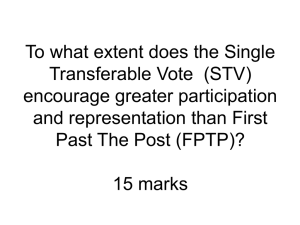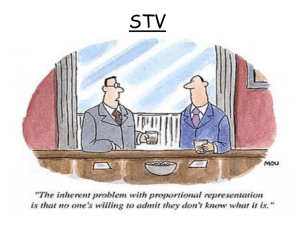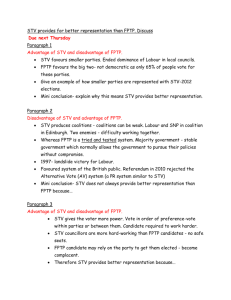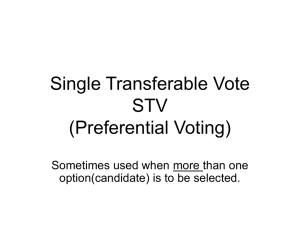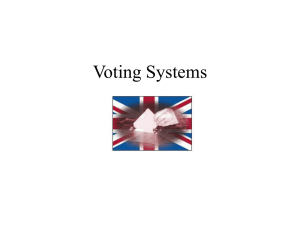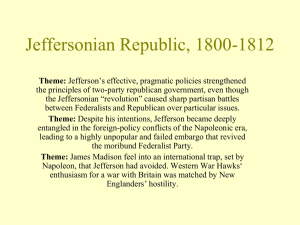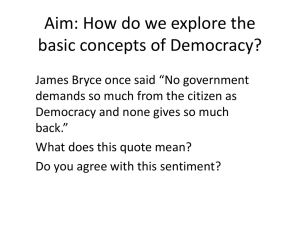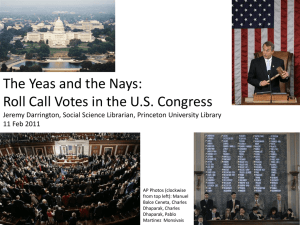STV.
advertisement
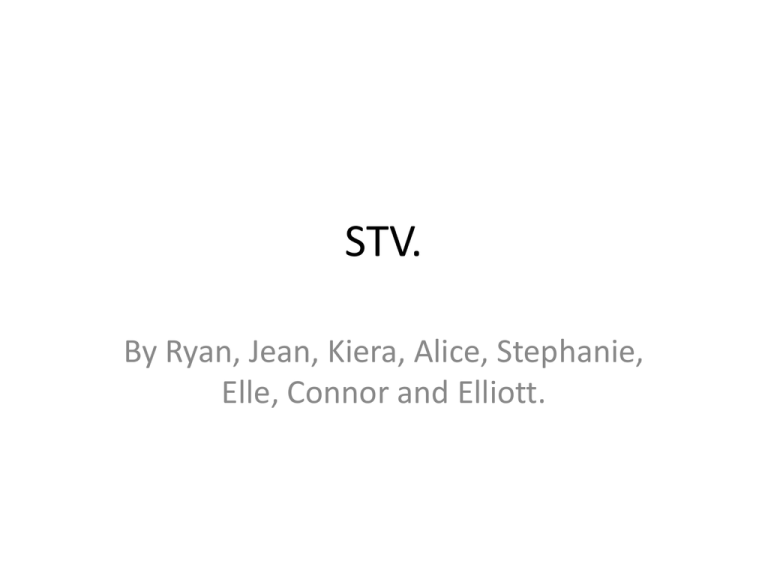
STV. By Ryan, Jean, Kiera, Alice, Stephanie, Elle, Connor and Elliott. STV is used in local authority elections in Scotland and in the Northern Irish assembly. In an STV election the parties can stand more than one candidate and voters have more than one vote. They rank candidates in order of preference putting a 1 for favourite and so on, depending on how many candidates there are. Votes get divvied out depending on first preference votes, and if a certain quota is reached at this point, the winner is now a councillor. If not, the votes are continued to be divvied out until someone wins. The quota is: Number of votes cast + 1 divided by number of votes cast in the constituency. Advantages and Disadvantages of STV – FAIRNESS & UNDEMOCRATICNESS • • • • • STV allows voters to choose within parties. Parties will usually nominate more than 1 candidate for election. This gives the voter more choice. In the 2007 local council elections, in the Bridge of Don ward the Lib Dem candidates Gordon Leslie and John Reynolds came 2nd and 3rd, and in AMS it would normally be only one Lib Dem candidate winning. All votes count and accurately represent the wishes of the voters, as all votes are tallied up and reallocated according to the quota. As no votes are wasted, it really does proportionally represent what the voters actually want in government. Smaller parties tend to get better representation because of the votes cast correlating to seats won. Leading on from this, smaller parties are given a tangible chance of obtaining representation because votes are translated proportionally to seats. In the 2007 local council elections the Green Party gained 2 seats. However, coalitions can lead to instability. The majority of local authorities are coalitions – 21 of 32. In the Edinburgh Council it is a Lib Dem/SNP coalition. It released a series of school closures which was very unpopular. SNP withdrew its support without consulting with the Lib Dems. Some parties actually form coalitions to exclude other parties, rather than for fairness or for optimum local government. In East Dunbartonshire the Labour party and Conservatives formed a coalition to keep the SNP out – despite having different views and policies! Disadvantages of FPTP: FPTP tends to create stable government, but stable government is not always good. In 2005, Lib Dems leader Charles Kennedy was opposed to the war in Iraq. An STV-run UK General Election probably would have created a hung parliament, resulting in seats for Lib Dems and an opportunity for them to voice their opinion. However, FPTP does not always produce decisive results. Despite supporters saying FPTP is good for the country as it produces clear results quickly, the 2010 election produced a hung parliament and a coalition between the Conservatives and the Lib Dems FPTP does create fair and democratic results. Seats are not proportional to votes cast by the electorate. This means that votes cast for a party are not the same as the seats they eventually receive in Parliament. There have been many cases in which this has happened. A notable example was in the 2005 General Election. The Lib Dems won 22% of the votes but only 10% of the seats. Labour became government with 35% of the vote gaining 55% of the seats. Disadvantages of AMS Voters might end up having an MSP they did not vote for. In August 2007, 3 months after coming into office the SNP MSP Stefan Tymkewycz resigned from the Scottish Parliament. SNP elected their new candidate Shirley-Anne Somervill with no voters getting an opinion or an opportunity to vote on their new MSP. The parties can be said to be more powerful than the voter, as they choose the list of potential candidates to be put forward. In 2003, Margo MacDonald resigned from SNP an became an Independent candidate. If she hadn’t left SNP it would have been unlikely that she had won. Due to inter-party disputes, a perfectly capable potential MSP may not get a chance. This example shows that the voters wanted Margo MacDonald to win, but the SNP would not have put her forward. Why is the myth that STV leads to a weak and unstable government and permanent toothless concensulism incorrect? STV does not always lead to a weak and unstable local government as 12 out of 32 governments are majority governments. It is not the majority of wards, but it shows that it can produce majority governments fairly easily. How many ballot papers are spoilt in STV elections, in comparison with AMS? • • In STV, around 2% of the votes (100,000 votes) were spoilt. This is due to the complicatedness of the STV system and the fact that the Scottish Parliament election was on the same day, increasing the number of spoilt ballots due to confusion in voters. However, in 2007, figures showed that 38,341 local government (STV) votes were rejected compared to about 140,000 in the Holyrood poll. WHY IS STV THE BEST? STV, out of the three electoral systems, is the most democratic. This is due to ALL VOTES BEING COUNTED, and the fact that SEATS ARE PROPORTIONAL REPRESENTATIONAL TO VOTES CAST. AMS and FPTP, to some extent, do not have these democratic elements.
